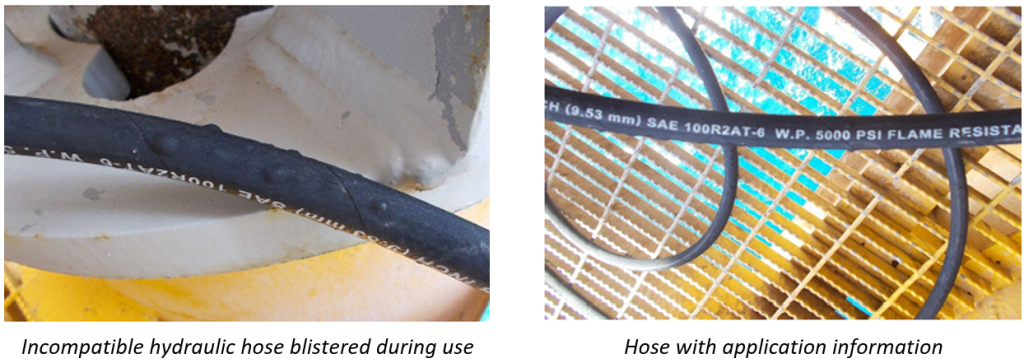BSEE: Improper use and application of high-pressure hoses
The United States Bureau of Safety and Environmental Enforcement (BSEE) has published Safety Alert 465 relating to the improper use and application of high-pressure hoses.
What happened
During a recent offshore inspection, a BSEE inspector observed operator personnel installing a 30m high pressure hose, with a Maximum Working Pressure (MWP) of 5000 psi, to test pressure safety valves on pipeline pumps. The hose used was designed for hydraulic fluid and was not suitable for high-pressure nitrogen; when nitrogen gas at 2500 psi was injected into the hydraulic hose, the hose blistered, allowing nitrogen gas to leak.

BSEE recommendations
BSEE recommends operators and their contractors, where appropriate, consider:
- Selecting hoses based on size, temperature, application, material to be conveyed, pressure, ends or couplings, and delivery;
- Sizing the inside diameter (I.D.) and outside diameter (O.D.) appropriately to minimize pressure loss and reduce heat generation;
- Choosing the appropriate hose size to match the new hose or referencing the original equipment manufacturer (OEM) for specifications of the equipment requiring the hose;
- Ensuring the operating temperature of the hose is similar in temperature to the fluid and ambient temperatures. Both high and low temperatures can have a significant effect on the efficiency, performance, and safety of the hose. Also, check for hot surfaces or hot exhaust in the area where the hose will be installed and consider re-routing the hose if a heat shield cannot be installed;
- Ensuring the hose is correct for the gas or fluid being carried;
- Checking for compatibility between the fluid and the hose materials, along with connections, couplings, and O-rings;
- Following manufacturer recommendations for hose inspection and replacement intervals. Frequent fluctuations in pressure and poor storage conditions may reduce hose life; consider these variations when determining replacement intervals for preventative maintenance;
- Immediately stopping usage or replacing hoses when they become damaged, cracked, cut, abraded, blistered, soft, kinked, crushed, flattened, or twisted;
- Always properly marking discontinued service hoses for disposal and quarantining them – storing them separately from new service hoses;
- Ensuring work permits and job safety analyses address the risks involved in working closely with pressurized hoses;
- Notifying personnel of the hazards of working around pressurized hoses and installing warnings and barriers.
Members may wish to refer to:
- BSEE Safety Alert 442 Unsecured Pressurized Hoses Result in Hand Injuries
- Hose management and chemicals: crew person felt ill
- Working with hoses and pressure
Safety Event
Published: 29 August 2023
Download: IMCA SF 21/23
IMCA Safety Flashes
Submit a Report
IMCA Safety Flashes summarise key safety matters and incidents, allowing lessons to be more easily learnt for the benefit of all. The effectiveness of the IMCA Safety Flash system depends on Members sharing information and so avoiding repeat incidents. Please consider adding [email protected] to your internal distribution list for safety alerts or manually submitting information on incidents you consider may be relevant. All information is anonymised or sanitised, as appropriate.
IMCA’s store terms and conditions (https://www.imca-int.com/legal-notices/terms/) apply to all downloads from IMCA’s website, including this document.
IMCA makes every effort to ensure the accuracy and reliability of the data contained in the documents it publishes, but IMCA shall not be liable for any guidance and/or recommendation and/or statement herein contained. The information contained in this document does not fulfil or replace any individual’s or Member's legal, regulatory or other duties or obligations in respect of their operations. Individuals and Members remain solely responsible for the safe, lawful and proper conduct of their operations.
